Analysis of Primark's Business Environment and Stakeholder Impact
VerifiedAdded on 2020/06/05
|12
|3185
|40
Report
AI Summary
This report provides a comprehensive analysis of Primark's business environment. It begins with an introduction to the business environment and its components, emphasizing the importance of stakeholders like employees, customers, suppliers, and the government. The report then delves into the different sectors of organizations, using Primark and Marks & Spencer as examples, and describes their stakeholders. It further examines organizational functions and their link to organizational structures, explaining how these structures help businesses fulfill their purposes. The influence of economic environments on business activities is explored, contrasting internal and external factors. Finally, the report discusses the impact of political, legal, and social factors on Primark's business activities and stakeholders, utilizing PESTEL analysis to understand these global factors. The analysis highlights how Primark navigates various challenges and opportunities within its operating environment, offering valuable insights into its strategic approach.
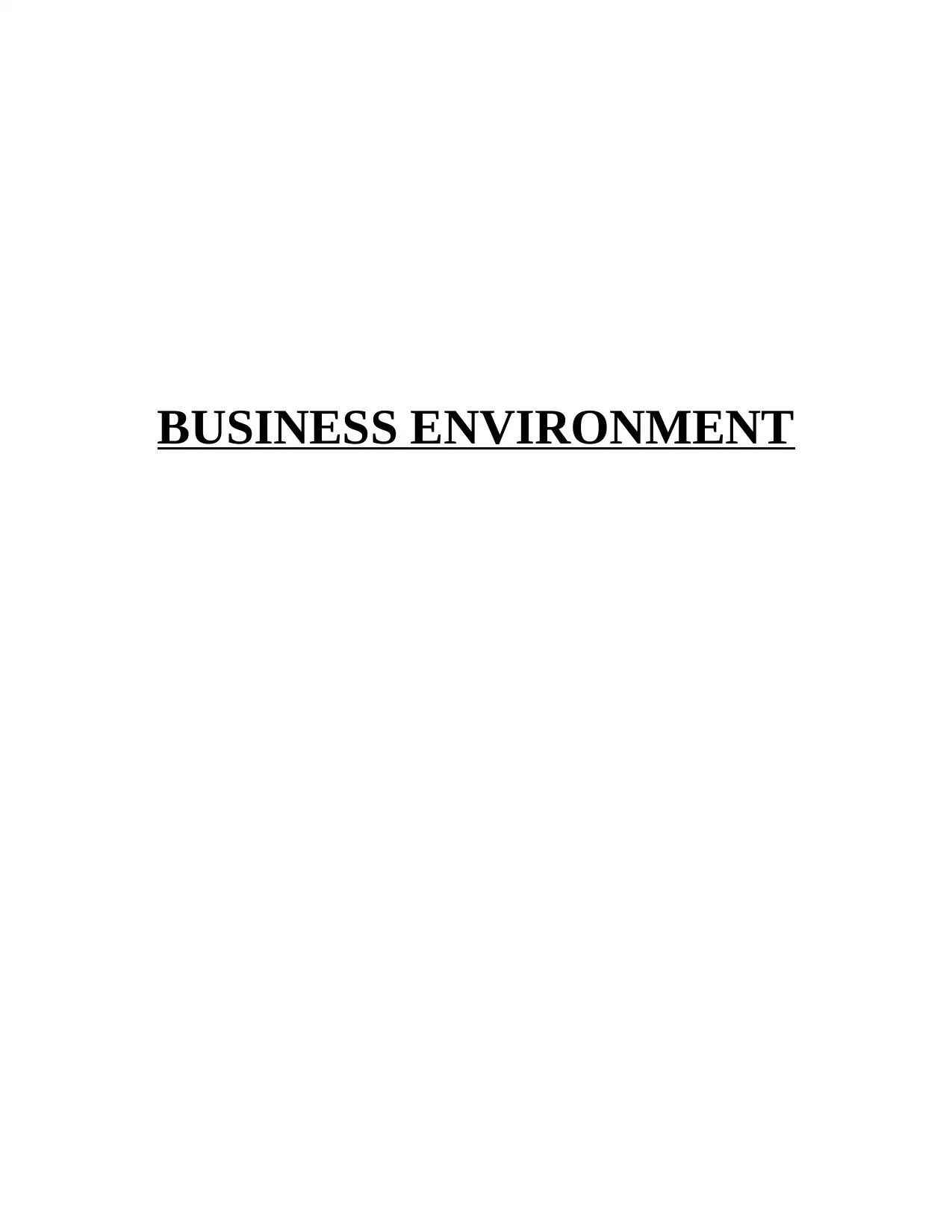
BUSINESS ENVIRONMENT
Paraphrase This Document
Need a fresh take? Get an instant paraphrase of this document with our AI Paraphraser
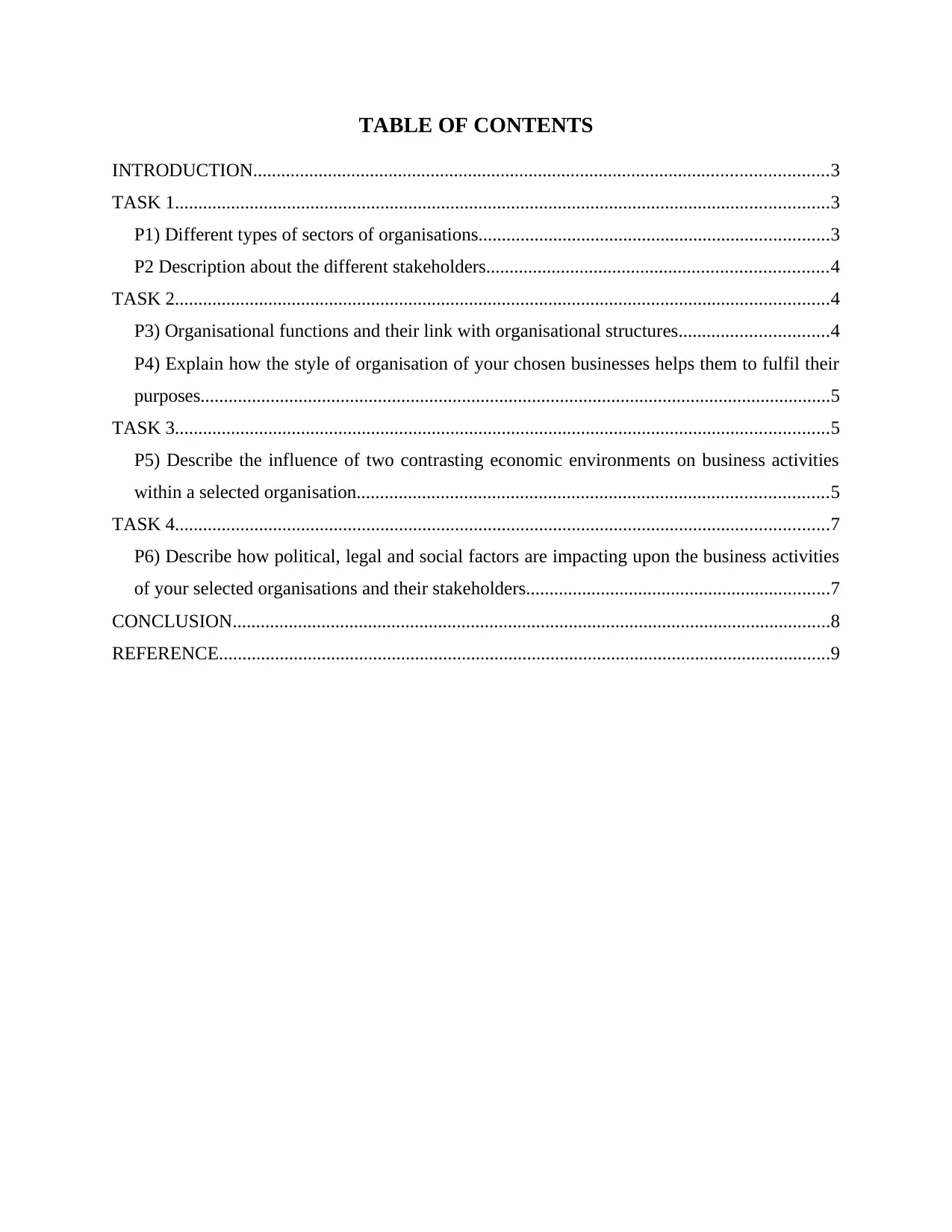
TABLE OF CONTENTS
INTRODUCTION...........................................................................................................................3
TASK 1............................................................................................................................................3
P1) Different types of sectors of organisations...........................................................................3
P2 Description about the different stakeholders.........................................................................4
TASK 2............................................................................................................................................4
P3) Organisational functions and their link with organisational structures................................4
P4) Explain how the style of organisation of your chosen businesses helps them to fulfil their
purposes.......................................................................................................................................5
TASK 3............................................................................................................................................5
P5) Describe the influence of two contrasting economic environments on business activities
within a selected organisation.....................................................................................................5
TASK 4............................................................................................................................................7
P6) Describe how political, legal and social factors are impacting upon the business activities
of your selected organisations and their stakeholders.................................................................7
CONCLUSION................................................................................................................................8
REFERENCE...................................................................................................................................9
INTRODUCTION...........................................................................................................................3
TASK 1............................................................................................................................................3
P1) Different types of sectors of organisations...........................................................................3
P2 Description about the different stakeholders.........................................................................4
TASK 2............................................................................................................................................4
P3) Organisational functions and their link with organisational structures................................4
P4) Explain how the style of organisation of your chosen businesses helps them to fulfil their
purposes.......................................................................................................................................5
TASK 3............................................................................................................................................5
P5) Describe the influence of two contrasting economic environments on business activities
within a selected organisation.....................................................................................................5
TASK 4............................................................................................................................................7
P6) Describe how political, legal and social factors are impacting upon the business activities
of your selected organisations and their stakeholders.................................................................7
CONCLUSION................................................................................................................................8
REFERENCE...................................................................................................................................9
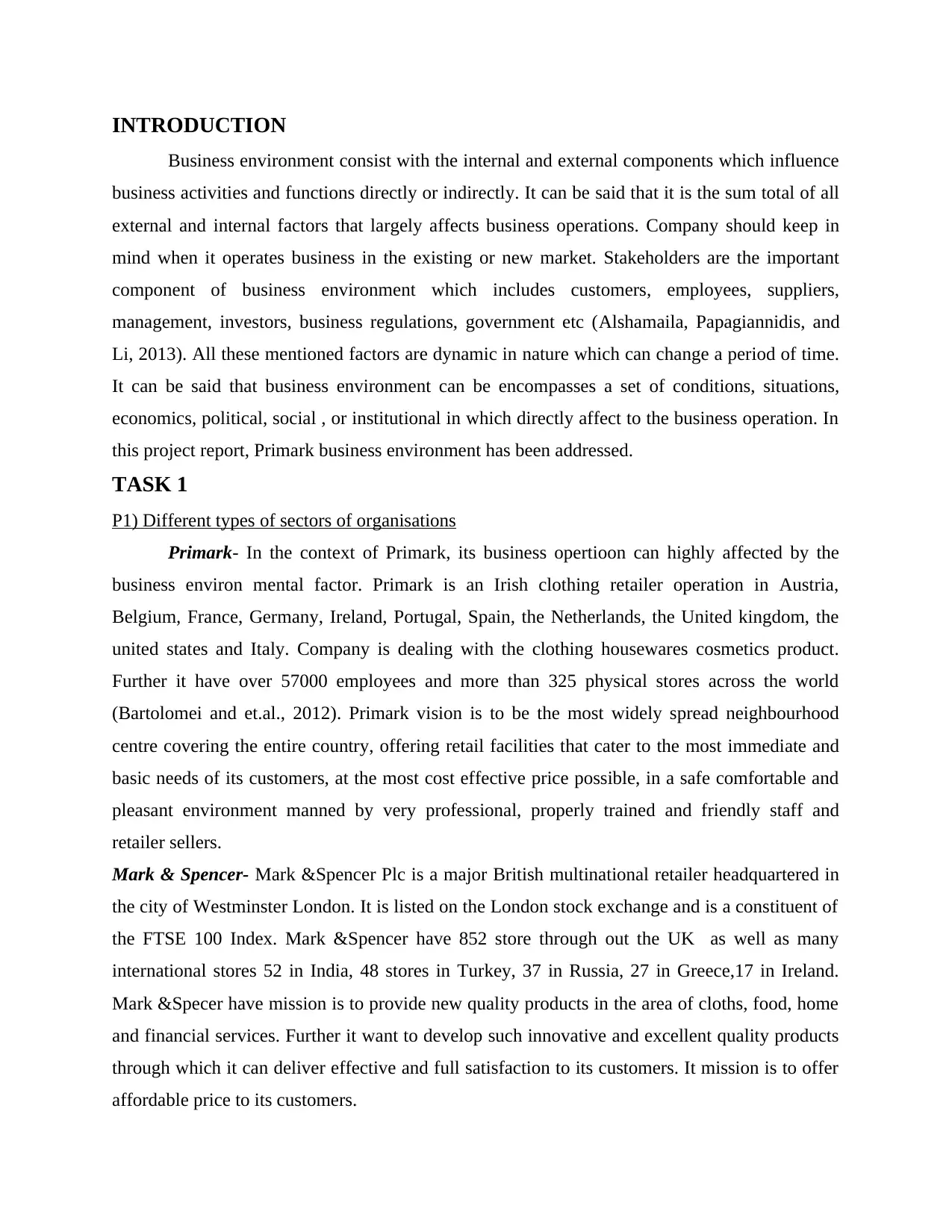
INTRODUCTION
Business environment consist with the internal and external components which influence
business activities and functions directly or indirectly. It can be said that it is the sum total of all
external and internal factors that largely affects business operations. Company should keep in
mind when it operates business in the existing or new market. Stakeholders are the important
component of business environment which includes customers, employees, suppliers,
management, investors, business regulations, government etc (Alshamaila, Papagiannidis, and
Li, 2013). All these mentioned factors are dynamic in nature which can change a period of time.
It can be said that business environment can be encompasses a set of conditions, situations,
economics, political, social , or institutional in which directly affect to the business operation. In
this project report, Primark business environment has been addressed.
TASK 1
P1) Different types of sectors of organisations
Primark- In the context of Primark, its business opertioon can highly affected by the
business environ mental factor. Primark is an Irish clothing retailer operation in Austria,
Belgium, France, Germany, Ireland, Portugal, Spain, the Netherlands, the United kingdom, the
united states and Italy. Company is dealing with the clothing housewares cosmetics product.
Further it have over 57000 employees and more than 325 physical stores across the world
(Bartolomei and et.al., 2012). Primark vision is to be the most widely spread neighbourhood
centre covering the entire country, offering retail facilities that cater to the most immediate and
basic needs of its customers, at the most cost effective price possible, in a safe comfortable and
pleasant environment manned by very professional, properly trained and friendly staff and
retailer sellers.
Mark & Spencer- Mark &Spencer Plc is a major British multinational retailer headquartered in
the city of Westminster London. It is listed on the London stock exchange and is a constituent of
the FTSE 100 Index. Mark &Spencer have 852 store through out the UK as well as many
international stores 52 in India, 48 stores in Turkey, 37 in Russia, 27 in Greece,17 in Ireland.
Mark &Specer have mission is to provide new quality products in the area of cloths, food, home
and financial services. Further it want to develop such innovative and excellent quality products
through which it can deliver effective and full satisfaction to its customers. It mission is to offer
affordable price to its customers.
Business environment consist with the internal and external components which influence
business activities and functions directly or indirectly. It can be said that it is the sum total of all
external and internal factors that largely affects business operations. Company should keep in
mind when it operates business in the existing or new market. Stakeholders are the important
component of business environment which includes customers, employees, suppliers,
management, investors, business regulations, government etc (Alshamaila, Papagiannidis, and
Li, 2013). All these mentioned factors are dynamic in nature which can change a period of time.
It can be said that business environment can be encompasses a set of conditions, situations,
economics, political, social , or institutional in which directly affect to the business operation. In
this project report, Primark business environment has been addressed.
TASK 1
P1) Different types of sectors of organisations
Primark- In the context of Primark, its business opertioon can highly affected by the
business environ mental factor. Primark is an Irish clothing retailer operation in Austria,
Belgium, France, Germany, Ireland, Portugal, Spain, the Netherlands, the United kingdom, the
united states and Italy. Company is dealing with the clothing housewares cosmetics product.
Further it have over 57000 employees and more than 325 physical stores across the world
(Bartolomei and et.al., 2012). Primark vision is to be the most widely spread neighbourhood
centre covering the entire country, offering retail facilities that cater to the most immediate and
basic needs of its customers, at the most cost effective price possible, in a safe comfortable and
pleasant environment manned by very professional, properly trained and friendly staff and
retailer sellers.
Mark & Spencer- Mark &Spencer Plc is a major British multinational retailer headquartered in
the city of Westminster London. It is listed on the London stock exchange and is a constituent of
the FTSE 100 Index. Mark &Spencer have 852 store through out the UK as well as many
international stores 52 in India, 48 stores in Turkey, 37 in Russia, 27 in Greece,17 in Ireland.
Mark &Specer have mission is to provide new quality products in the area of cloths, food, home
and financial services. Further it want to develop such innovative and excellent quality products
through which it can deliver effective and full satisfaction to its customers. It mission is to offer
affordable price to its customers.
⊘ This is a preview!⊘
Do you want full access?
Subscribe today to unlock all pages.

Trusted by 1+ million students worldwide

P2 Description about the different stakeholders
Stakeholders are largely influenced internal and external functioning of company. These are that
bodies who has directly or indirectly influenced by corporation’s policies, practices, growth and
decline. Employees- These are people who want to interested in the company financial position.
Company should maintain effective relationship with the personnels because the entire
activities and functions of business are depends upon the employees performance.
Corporation have responsibility to disclose each and every practices, policies and other
information related to the business with employees. Customers- They are another important stakeholder for company. Primark have to
maintain effective relationship with customers by provide them effective and excellent
quality of goods and services (Butler and et.al., 2013). Company have to render effective
quality goods and services and produce such products which can provide effective
satisfaction to them. Suppliers-Suppler are those people who supply raw materials and semi finished good to
corporation. They are interested to know the financial condition of the company. Further
they also required that firm paid to them in accordance with the terms and condition of
contract.
Government- This is the major stakeholder which primark have to considered. Company
can maintain effective relationship with government buy paying tax time to time. Further
company have to follow the rules and regulation of business operation ion the market.
Firm should obey the legislation and code of conduct which has govern by the
government.
TASK 2
P3) Organisational functions and their link with organisational structures
Organizational structure refers to the method that an organization arranges employee to
increase the productivity and achieve the organization goals. It defines the task, responsibilities,
work roles and relationship, and channel of communication. An organization structure can be
plan in many different ways depend on the organization objective, the modes in operation and
business types.
Stakeholders are largely influenced internal and external functioning of company. These are that
bodies who has directly or indirectly influenced by corporation’s policies, practices, growth and
decline. Employees- These are people who want to interested in the company financial position.
Company should maintain effective relationship with the personnels because the entire
activities and functions of business are depends upon the employees performance.
Corporation have responsibility to disclose each and every practices, policies and other
information related to the business with employees. Customers- They are another important stakeholder for company. Primark have to
maintain effective relationship with customers by provide them effective and excellent
quality of goods and services (Butler and et.al., 2013). Company have to render effective
quality goods and services and produce such products which can provide effective
satisfaction to them. Suppliers-Suppler are those people who supply raw materials and semi finished good to
corporation. They are interested to know the financial condition of the company. Further
they also required that firm paid to them in accordance with the terms and condition of
contract.
Government- This is the major stakeholder which primark have to considered. Company
can maintain effective relationship with government buy paying tax time to time. Further
company have to follow the rules and regulation of business operation ion the market.
Firm should obey the legislation and code of conduct which has govern by the
government.
TASK 2
P3) Organisational functions and their link with organisational structures
Organizational structure refers to the method that an organization arranges employee to
increase the productivity and achieve the organization goals. It defines the task, responsibilities,
work roles and relationship, and channel of communication. An organization structure can be
plan in many different ways depend on the organization objective, the modes in operation and
business types.
Paraphrase This Document
Need a fresh take? Get an instant paraphrase of this document with our AI Paraphraser
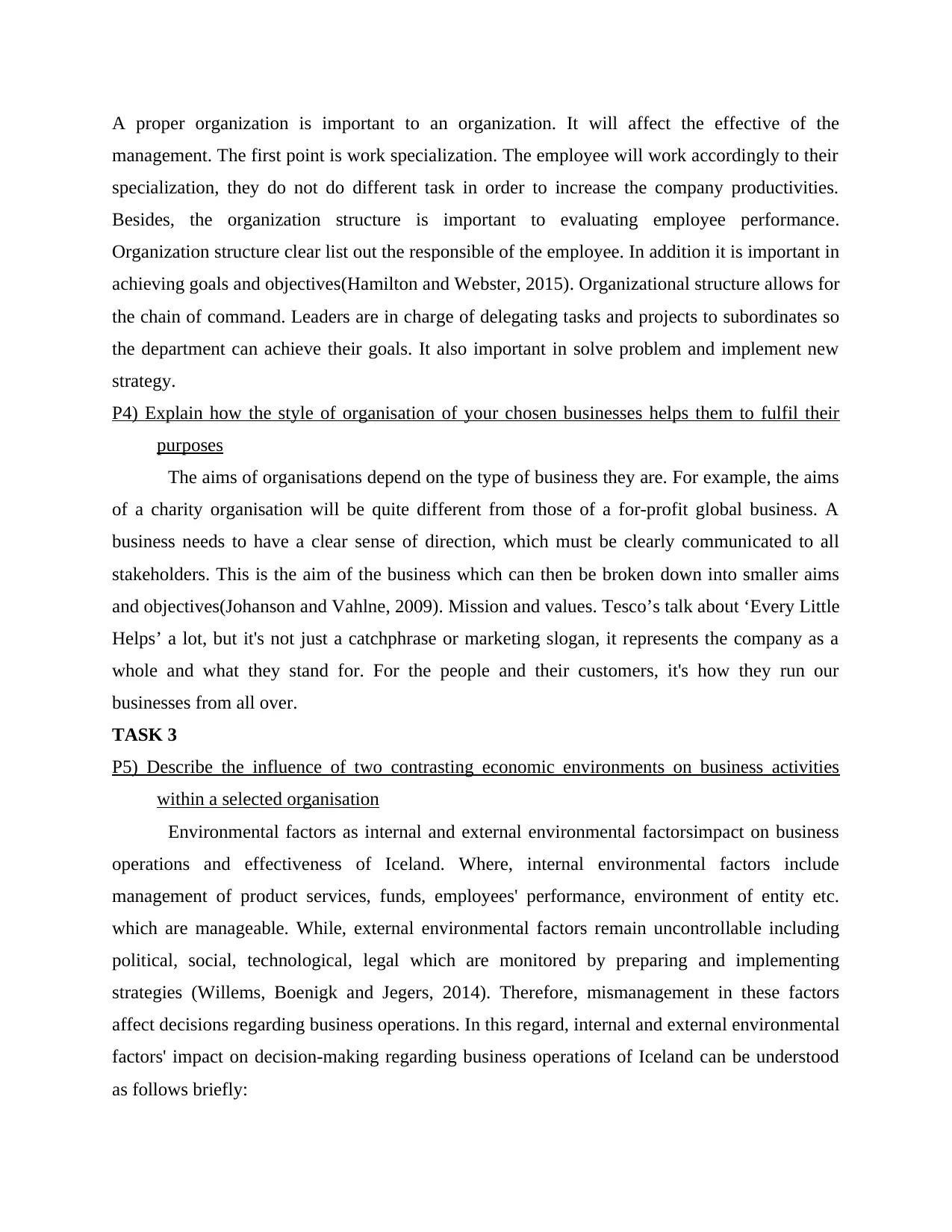
A proper organization is important to an organization. It will affect the effective of the
management. The first point is work specialization. The employee will work accordingly to their
specialization, they do not do different task in order to increase the company productivities.
Besides, the organization structure is important to evaluating employee performance.
Organization structure clear list out the responsible of the employee. In addition it is important in
achieving goals and objectives(Hamilton and Webster, 2015). Organizational structure allows for
the chain of command. Leaders are in charge of delegating tasks and projects to subordinates so
the department can achieve their goals. It also important in solve problem and implement new
strategy.
P4) Explain how the style of organisation of your chosen businesses helps them to fulfil their
purposes
The aims of organisations depend on the type of business they are. For example, the aims
of a charity organisation will be quite different from those of a for-profit global business. A
business needs to have a clear sense of direction, which must be clearly communicated to all
stakeholders. This is the aim of the business which can then be broken down into smaller aims
and objectives(Johanson and Vahlne, 2009). Mission and values. Tesco’s talk about ‘Every Little
Helps’ a lot, but it's not just a catchphrase or marketing slogan, it represents the company as a
whole and what they stand for. For the people and their customers, it's how they run our
businesses from all over.
TASK 3
P5) Describe the influence of two contrasting economic environments on business activities
within a selected organisation
Environmental factors as internal and external environmental factorsimpact on business
operations and effectiveness of Iceland. Where, internal environmental factors include
management of product services, funds, employees' performance, environment of entity etc.
which are manageable. While, external environmental factors remain uncontrollable including
political, social, technological, legal which are monitored by preparing and implementing
strategies (Willems, Boenigk and Jegers, 2014). Therefore, mismanagement in these factors
affect decisions regarding business operations. In this regard, internal and external environmental
factors' impact on decision-making regarding business operations of Iceland can be understood
as follows briefly:
management. The first point is work specialization. The employee will work accordingly to their
specialization, they do not do different task in order to increase the company productivities.
Besides, the organization structure is important to evaluating employee performance.
Organization structure clear list out the responsible of the employee. In addition it is important in
achieving goals and objectives(Hamilton and Webster, 2015). Organizational structure allows for
the chain of command. Leaders are in charge of delegating tasks and projects to subordinates so
the department can achieve their goals. It also important in solve problem and implement new
strategy.
P4) Explain how the style of organisation of your chosen businesses helps them to fulfil their
purposes
The aims of organisations depend on the type of business they are. For example, the aims
of a charity organisation will be quite different from those of a for-profit global business. A
business needs to have a clear sense of direction, which must be clearly communicated to all
stakeholders. This is the aim of the business which can then be broken down into smaller aims
and objectives(Johanson and Vahlne, 2009). Mission and values. Tesco’s talk about ‘Every Little
Helps’ a lot, but it's not just a catchphrase or marketing slogan, it represents the company as a
whole and what they stand for. For the people and their customers, it's how they run our
businesses from all over.
TASK 3
P5) Describe the influence of two contrasting economic environments on business activities
within a selected organisation
Environmental factors as internal and external environmental factorsimpact on business
operations and effectiveness of Iceland. Where, internal environmental factors include
management of product services, funds, employees' performance, environment of entity etc.
which are manageable. While, external environmental factors remain uncontrollable including
political, social, technological, legal which are monitored by preparing and implementing
strategies (Willems, Boenigk and Jegers, 2014). Therefore, mismanagement in these factors
affect decisions regarding business operations. In this regard, internal and external environmental
factors' impact on decision-making regarding business operations of Iceland can be understood
as follows briefly:
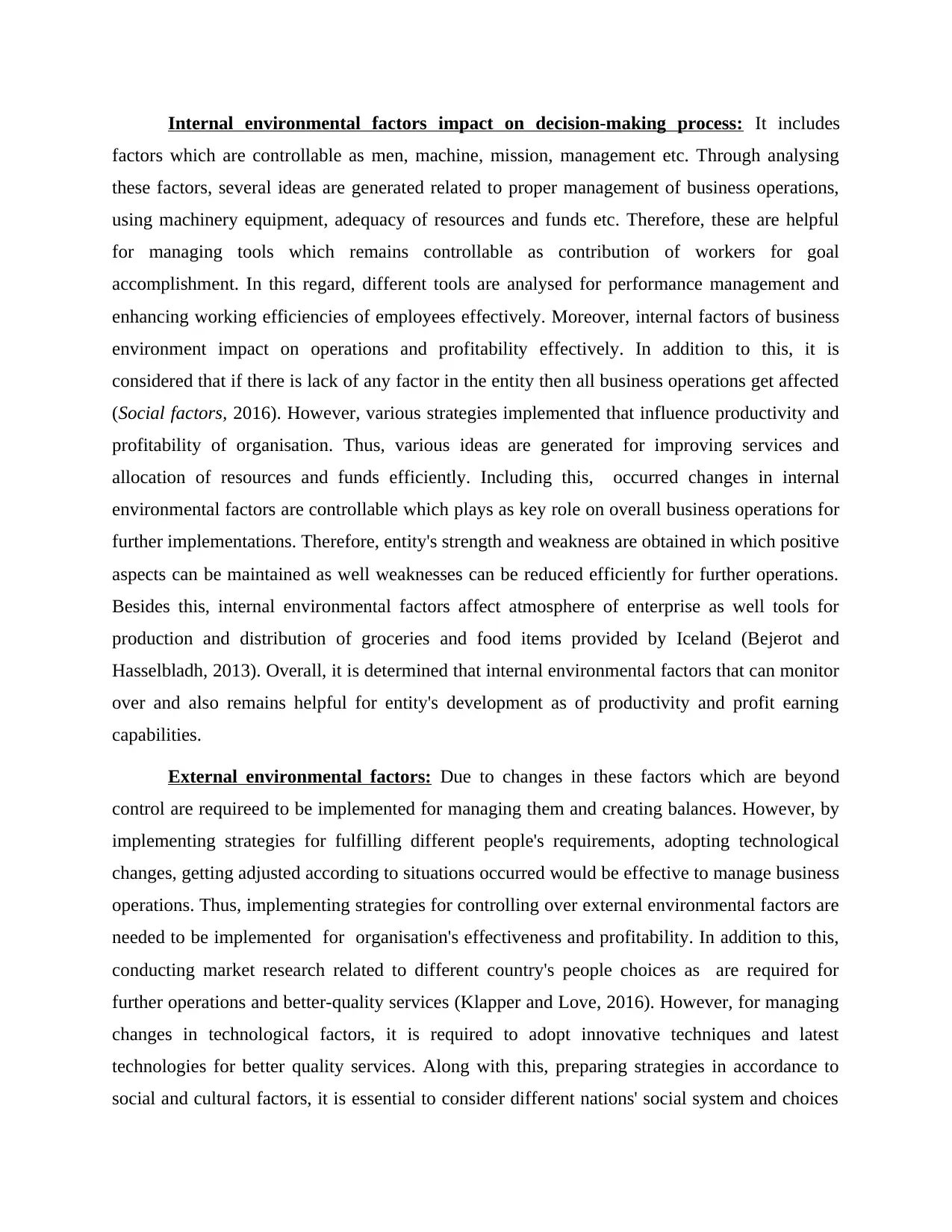
Internal environmental factors impact on decision-making process: It includes
factors which are controllable as men, machine, mission, management etc. Through analysing
these factors, several ideas are generated related to proper management of business operations,
using machinery equipment, adequacy of resources and funds etc. Therefore, these are helpful
for managing tools which remains controllable as contribution of workers for goal
accomplishment. In this regard, different tools are analysed for performance management and
enhancing working efficiencies of employees effectively. Moreover, internal factors of business
environment impact on operations and profitability effectively. In addition to this, it is
considered that if there is lack of any factor in the entity then all business operations get affected
(Social factors, 2016). However, various strategies implemented that influence productivity and
profitability of organisation. Thus, various ideas are generated for improving services and
allocation of resources and funds efficiently. Including this, occurred changes in internal
environmental factors are controllable which plays as key role on overall business operations for
further implementations. Therefore, entity's strength and weakness are obtained in which positive
aspects can be maintained as well weaknesses can be reduced efficiently for further operations.
Besides this, internal environmental factors affect atmosphere of enterprise as well tools for
production and distribution of groceries and food items provided by Iceland (Bejerot and
Hasselbladh, 2013). Overall, it is determined that internal environmental factors that can monitor
over and also remains helpful for entity's development as of productivity and profit earning
capabilities.
External environmental factors: Due to changes in these factors which are beyond
control are requireed to be implemented for managing them and creating balances. However, by
implementing strategies for fulfilling different people's requirements, adopting technological
changes, getting adjusted according to situations occurred would be effective to manage business
operations. Thus, implementing strategies for controlling over external environmental factors are
needed to be implemented for organisation's effectiveness and profitability. In addition to this,
conducting market research related to different country's people choices as are required for
further operations and better-quality services (Klapper and Love, 2016). However, for managing
changes in technological factors, it is required to adopt innovative techniques and latest
technologies for better quality services. Along with this, preparing strategies in accordance to
social and cultural factors, it is essential to consider different nations' social system and choices
factors which are controllable as men, machine, mission, management etc. Through analysing
these factors, several ideas are generated related to proper management of business operations,
using machinery equipment, adequacy of resources and funds etc. Therefore, these are helpful
for managing tools which remains controllable as contribution of workers for goal
accomplishment. In this regard, different tools are analysed for performance management and
enhancing working efficiencies of employees effectively. Moreover, internal factors of business
environment impact on operations and profitability effectively. In addition to this, it is
considered that if there is lack of any factor in the entity then all business operations get affected
(Social factors, 2016). However, various strategies implemented that influence productivity and
profitability of organisation. Thus, various ideas are generated for improving services and
allocation of resources and funds efficiently. Including this, occurred changes in internal
environmental factors are controllable which plays as key role on overall business operations for
further implementations. Therefore, entity's strength and weakness are obtained in which positive
aspects can be maintained as well weaknesses can be reduced efficiently for further operations.
Besides this, internal environmental factors affect atmosphere of enterprise as well tools for
production and distribution of groceries and food items provided by Iceland (Bejerot and
Hasselbladh, 2013). Overall, it is determined that internal environmental factors that can monitor
over and also remains helpful for entity's development as of productivity and profit earning
capabilities.
External environmental factors: Due to changes in these factors which are beyond
control are requireed to be implemented for managing them and creating balances. However, by
implementing strategies for fulfilling different people's requirements, adopting technological
changes, getting adjusted according to situations occurred would be effective to manage business
operations. Thus, implementing strategies for controlling over external environmental factors are
needed to be implemented for organisation's effectiveness and profitability. In addition to this,
conducting market research related to different country's people choices as are required for
further operations and better-quality services (Klapper and Love, 2016). However, for managing
changes in technological factors, it is required to adopt innovative techniques and latest
technologies for better quality services. Along with this, preparing strategies in accordance to
social and cultural factors, it is essential to consider different nations' social system and choices
⊘ This is a preview!⊘
Do you want full access?
Subscribe today to unlock all pages.

Trusted by 1+ million students worldwide
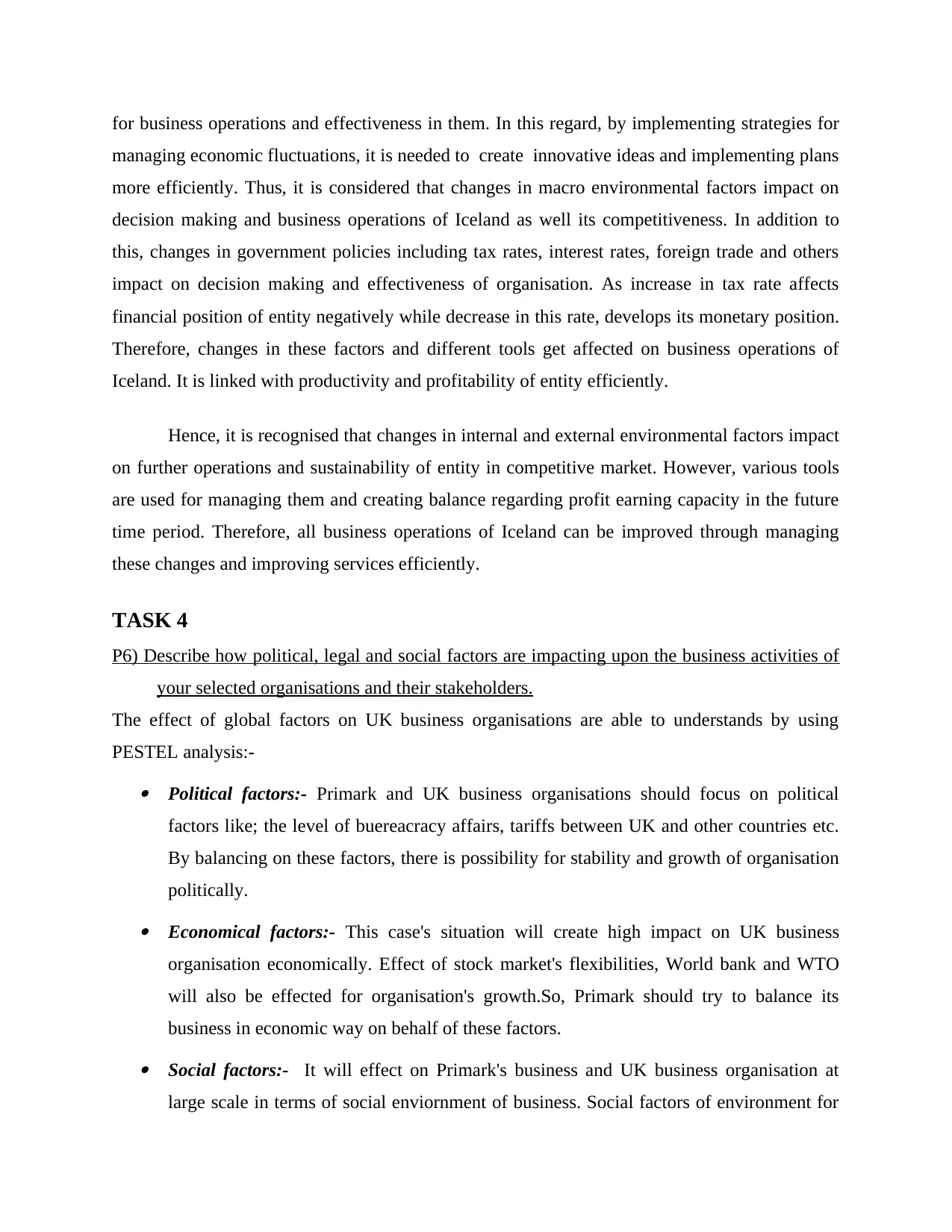
for business operations and effectiveness in them. In this regard, by implementing strategies for
managing economic fluctuations, it is needed to create innovative ideas and implementing plans
more efficiently. Thus, it is considered that changes in macro environmental factors impact on
decision making and business operations of Iceland as well its competitiveness. In addition to
this, changes in government policies including tax rates, interest rates, foreign trade and others
impact on decision making and effectiveness of organisation. As increase in tax rate affects
financial position of entity negatively while decrease in this rate, develops its monetary position.
Therefore, changes in these factors and different tools get affected on business operations of
Iceland. It is linked with productivity and profitability of entity efficiently.
Hence, it is recognised that changes in internal and external environmental factors impact
on further operations and sustainability of entity in competitive market. However, various tools
are used for managing them and creating balance regarding profit earning capacity in the future
time period. Therefore, all business operations of Iceland can be improved through managing
these changes and improving services efficiently.
TASK 4
P6) Describe how political, legal and social factors are impacting upon the business activities of
your selected organisations and their stakeholders.
The effect of global factors on UK business organisations are able to understands by using
PESTEL analysis:- Political factors:- Primark and UK business organisations should focus on political
factors like; the level of buereacracy affairs, tariffs between UK and other countries etc.
By balancing on these factors, there is possibility for stability and growth of organisation
politically. Economical factors:- This case's situation will create high impact on UK business
organisation economically. Effect of stock market's flexibilities, World bank and WTO
will also be effected for organisation's growth.So, Primark should try to balance its
business in economic way on behalf of these factors. Social factors:- It will effect on Primark's business and UK business organisation at
large scale in terms of social enviornment of business. Social factors of environment for
managing economic fluctuations, it is needed to create innovative ideas and implementing plans
more efficiently. Thus, it is considered that changes in macro environmental factors impact on
decision making and business operations of Iceland as well its competitiveness. In addition to
this, changes in government policies including tax rates, interest rates, foreign trade and others
impact on decision making and effectiveness of organisation. As increase in tax rate affects
financial position of entity negatively while decrease in this rate, develops its monetary position.
Therefore, changes in these factors and different tools get affected on business operations of
Iceland. It is linked with productivity and profitability of entity efficiently.
Hence, it is recognised that changes in internal and external environmental factors impact
on further operations and sustainability of entity in competitive market. However, various tools
are used for managing them and creating balance regarding profit earning capacity in the future
time period. Therefore, all business operations of Iceland can be improved through managing
these changes and improving services efficiently.
TASK 4
P6) Describe how political, legal and social factors are impacting upon the business activities of
your selected organisations and their stakeholders.
The effect of global factors on UK business organisations are able to understands by using
PESTEL analysis:- Political factors:- Primark and UK business organisations should focus on political
factors like; the level of buereacracy affairs, tariffs between UK and other countries etc.
By balancing on these factors, there is possibility for stability and growth of organisation
politically. Economical factors:- This case's situation will create high impact on UK business
organisation economically. Effect of stock market's flexibilities, World bank and WTO
will also be effected for organisation's growth.So, Primark should try to balance its
business in economic way on behalf of these factors. Social factors:- It will effect on Primark's business and UK business organisation at
large scale in terms of social enviornment of business. Social factors of environment for
Paraphrase This Document
Need a fresh take? Get an instant paraphrase of this document with our AI Paraphraser

business will be as; increasing popularity of immigration and transferring practices and
also greater concern for minorities in societies. Technological factors:- Due to situation, technological factors will effect on UK
business organisations as in continuous emergence of new communication technologies.
There would be innovative techniques occurs and level of global technological
infrastructure will also be effected. So, Primark and UK organisations will have to focus
on these factors for expansion of business. Ecological factors:- These factors are related to increasing levels of air and pollution and
impact of global warming tendencies. These factors plays great role to impact on UK
business organisations during the case. Ecology of business will effect globally.
Legal factors:- Global data protection laws will effect due to case's circumstances. Thus,
organisation should increase its level of legal globalisation and accept changes in cross
country employment and health and safety laws (Caiazza and Audretsch, 2015).
CONCLUSION
In this report, it is concluded that changes in environmental factors affect organisation's
effectiveness and business operations. In this regard, different sector organisations' purposes,
size, vision and mission are described. However, various organisational functions and their link
with organisational structure of Iceland is presented that is essential for creating coordination
among them and improving organisation's performance. Moreover, internal and external
environmental factors including SWOT and PESTLE are understood that affect decision-making
regarding further business operations and profitability of entity. In addition to this,
interrelationship between internal and external environmental factors is described that impacts on
business operations and different business activities. Therefore, significance of strategic planning
for getting adjusted towards occurred changes are understood through this report.
also greater concern for minorities in societies. Technological factors:- Due to situation, technological factors will effect on UK
business organisations as in continuous emergence of new communication technologies.
There would be innovative techniques occurs and level of global technological
infrastructure will also be effected. So, Primark and UK organisations will have to focus
on these factors for expansion of business. Ecological factors:- These factors are related to increasing levels of air and pollution and
impact of global warming tendencies. These factors plays great role to impact on UK
business organisations during the case. Ecology of business will effect globally.
Legal factors:- Global data protection laws will effect due to case's circumstances. Thus,
organisation should increase its level of legal globalisation and accept changes in cross
country employment and health and safety laws (Caiazza and Audretsch, 2015).
CONCLUSION
In this report, it is concluded that changes in environmental factors affect organisation's
effectiveness and business operations. In this regard, different sector organisations' purposes,
size, vision and mission are described. However, various organisational functions and their link
with organisational structure of Iceland is presented that is essential for creating coordination
among them and improving organisation's performance. Moreover, internal and external
environmental factors including SWOT and PESTLE are understood that affect decision-making
regarding further business operations and profitability of entity. In addition to this,
interrelationship between internal and external environmental factors is described that impacts on
business operations and different business activities. Therefore, significance of strategic planning
for getting adjusted towards occurred changes are understood through this report.
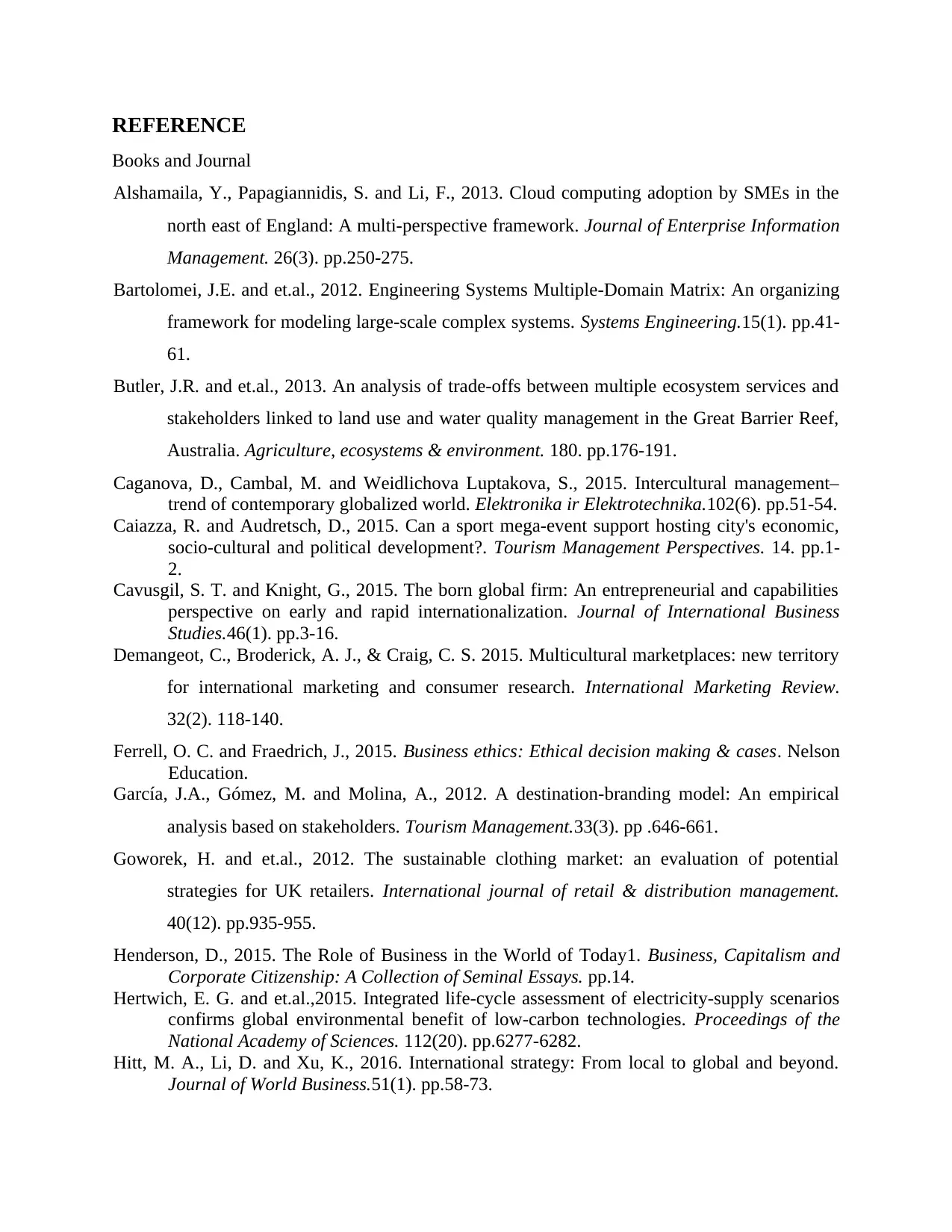
REFERENCE
Books and Journal
Alshamaila, Y., Papagiannidis, S. and Li, F., 2013. Cloud computing adoption by SMEs in the
north east of England: A multi-perspective framework. Journal of Enterprise Information
Management. 26(3). pp.250-275.
Bartolomei, J.E. and et.al., 2012. Engineering Systems Multiple‐Domain Matrix: An organizing
framework for modeling large‐scale complex systems. Systems Engineering.15(1). pp.41-
61.
Butler, J.R. and et.al., 2013. An analysis of trade-offs between multiple ecosystem services and
stakeholders linked to land use and water quality management in the Great Barrier Reef,
Australia. Agriculture, ecosystems & environment. 180. pp.176-191.
Caganova, D., Cambal, M. and Weidlichova Luptakova, S., 2015. Intercultural management–
trend of contemporary globalized world. Elektronika ir Elektrotechnika.102(6). pp.51-54.
Caiazza, R. and Audretsch, D., 2015. Can a sport mega-event support hosting city's economic,
socio-cultural and political development?. Tourism Management Perspectives. 14. pp.1-
2.
Cavusgil, S. T. and Knight, G., 2015. The born global firm: An entrepreneurial and capabilities
perspective on early and rapid internationalization. Journal of International Business
Studies.46(1). pp.3-16.
Demangeot, C., Broderick, A. J., & Craig, C. S. 2015. Multicultural marketplaces: new territory
for international marketing and consumer research. International Marketing Review.
32(2). 118-140.
Ferrell, O. C. and Fraedrich, J., 2015. Business ethics: Ethical decision making & cases. Nelson
Education.
García, J.A., Gómez, M. and Molina, A., 2012. A destination-branding model: An empirical
analysis based on stakeholders. Tourism Management.33(3). pp .646-661.
Goworek, H. and et.al., 2012. The sustainable clothing market: an evaluation of potential
strategies for UK retailers. International journal of retail & distribution management.
40(12). pp.935-955.
Henderson, D., 2015. The Role of Business in the World of Today1. Business, Capitalism and
Corporate Citizenship: A Collection of Seminal Essays. pp.14.
Hertwich, E. G. and et.al.,2015. Integrated life-cycle assessment of electricity-supply scenarios
confirms global environmental benefit of low-carbon technologies. Proceedings of the
National Academy of Sciences. 112(20). pp.6277-6282.
Hitt, M. A., Li, D. and Xu, K., 2016. International strategy: From local to global and beyond.
Journal of World Business.51(1). pp.58-73.
Books and Journal
Alshamaila, Y., Papagiannidis, S. and Li, F., 2013. Cloud computing adoption by SMEs in the
north east of England: A multi-perspective framework. Journal of Enterprise Information
Management. 26(3). pp.250-275.
Bartolomei, J.E. and et.al., 2012. Engineering Systems Multiple‐Domain Matrix: An organizing
framework for modeling large‐scale complex systems. Systems Engineering.15(1). pp.41-
61.
Butler, J.R. and et.al., 2013. An analysis of trade-offs between multiple ecosystem services and
stakeholders linked to land use and water quality management in the Great Barrier Reef,
Australia. Agriculture, ecosystems & environment. 180. pp.176-191.
Caganova, D., Cambal, M. and Weidlichova Luptakova, S., 2015. Intercultural management–
trend of contemporary globalized world. Elektronika ir Elektrotechnika.102(6). pp.51-54.
Caiazza, R. and Audretsch, D., 2015. Can a sport mega-event support hosting city's economic,
socio-cultural and political development?. Tourism Management Perspectives. 14. pp.1-
2.
Cavusgil, S. T. and Knight, G., 2015. The born global firm: An entrepreneurial and capabilities
perspective on early and rapid internationalization. Journal of International Business
Studies.46(1). pp.3-16.
Demangeot, C., Broderick, A. J., & Craig, C. S. 2015. Multicultural marketplaces: new territory
for international marketing and consumer research. International Marketing Review.
32(2). 118-140.
Ferrell, O. C. and Fraedrich, J., 2015. Business ethics: Ethical decision making & cases. Nelson
Education.
García, J.A., Gómez, M. and Molina, A., 2012. A destination-branding model: An empirical
analysis based on stakeholders. Tourism Management.33(3). pp .646-661.
Goworek, H. and et.al., 2012. The sustainable clothing market: an evaluation of potential
strategies for UK retailers. International journal of retail & distribution management.
40(12). pp.935-955.
Henderson, D., 2015. The Role of Business in the World of Today1. Business, Capitalism and
Corporate Citizenship: A Collection of Seminal Essays. pp.14.
Hertwich, E. G. and et.al.,2015. Integrated life-cycle assessment of electricity-supply scenarios
confirms global environmental benefit of low-carbon technologies. Proceedings of the
National Academy of Sciences. 112(20). pp.6277-6282.
Hitt, M. A., Li, D. and Xu, K., 2016. International strategy: From local to global and beyond.
Journal of World Business.51(1). pp.58-73.
⊘ This is a preview!⊘
Do you want full access?
Subscribe today to unlock all pages.

Trusted by 1+ million students worldwide
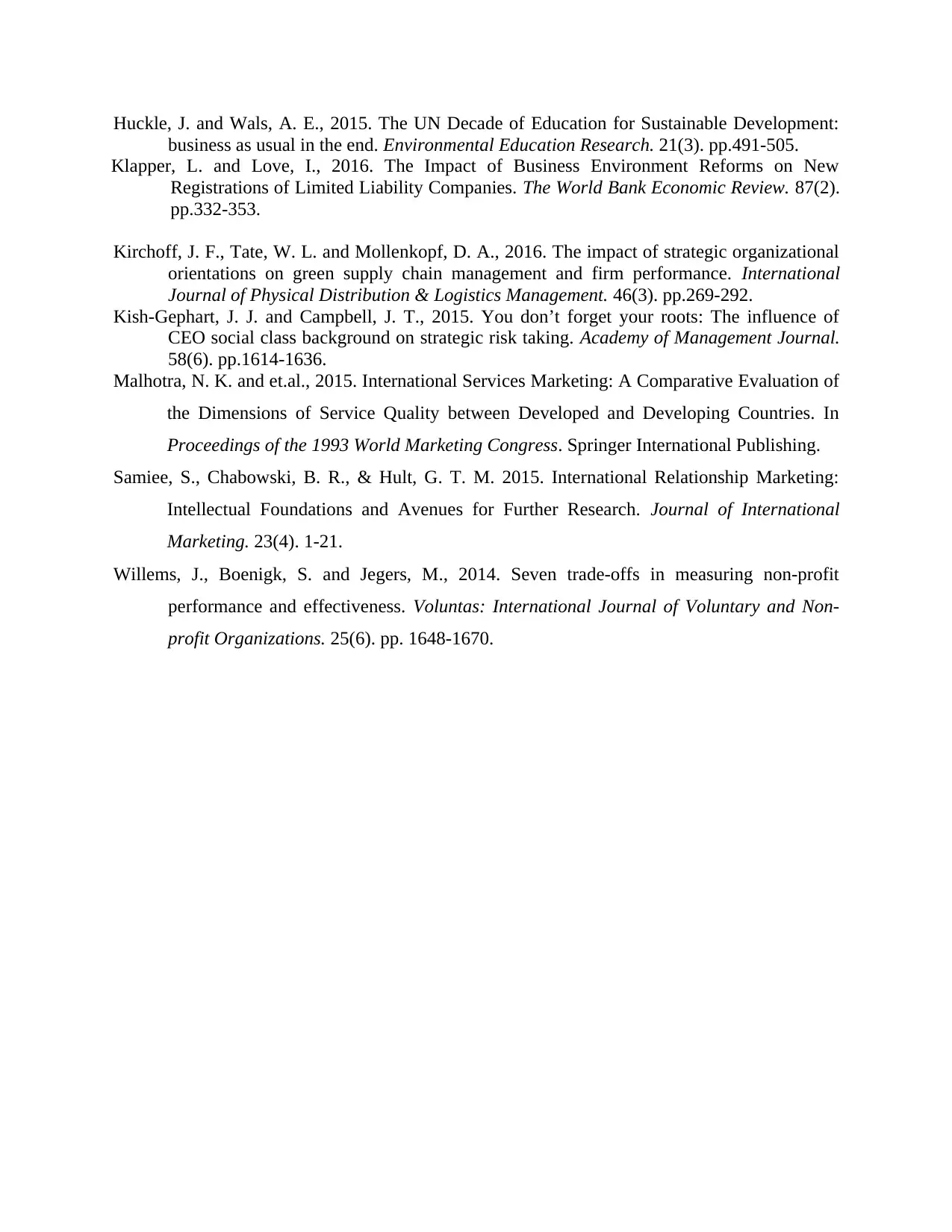
Huckle, J. and Wals, A. E., 2015. The UN Decade of Education for Sustainable Development:
business as usual in the end. Environmental Education Research. 21(3). pp.491-505.
Klapper, L. and Love, I., 2016. The Impact of Business Environment Reforms on New
Registrations of Limited Liability Companies. The World Bank Economic Review. 87(2).
pp.332-353.
Kirchoff, J. F., Tate, W. L. and Mollenkopf, D. A., 2016. The impact of strategic organizational
orientations on green supply chain management and firm performance. International
Journal of Physical Distribution & Logistics Management. 46(3). pp.269-292.
Kish-Gephart, J. J. and Campbell, J. T., 2015. You don’t forget your roots: The influence of
CEO social class background on strategic risk taking. Academy of Management Journal.
58(6). pp.1614-1636.
Malhotra, N. K. and et.al., 2015. International Services Marketing: A Comparative Evaluation of
the Dimensions of Service Quality between Developed and Developing Countries. In
Proceedings of the 1993 World Marketing Congress. Springer International Publishing.
Samiee, S., Chabowski, B. R., & Hult, G. T. M. 2015. International Relationship Marketing:
Intellectual Foundations and Avenues for Further Research. Journal of International
Marketing. 23(4). 1-21.
Willems, J., Boenigk, S. and Jegers, M., 2014. Seven trade-offs in measuring non-profit
performance and effectiveness. Voluntas: International Journal of Voluntary and Non-
profit Organizations. 25(6). pp. 1648-1670.
business as usual in the end. Environmental Education Research. 21(3). pp.491-505.
Klapper, L. and Love, I., 2016. The Impact of Business Environment Reforms on New
Registrations of Limited Liability Companies. The World Bank Economic Review. 87(2).
pp.332-353.
Kirchoff, J. F., Tate, W. L. and Mollenkopf, D. A., 2016. The impact of strategic organizational
orientations on green supply chain management and firm performance. International
Journal of Physical Distribution & Logistics Management. 46(3). pp.269-292.
Kish-Gephart, J. J. and Campbell, J. T., 2015. You don’t forget your roots: The influence of
CEO social class background on strategic risk taking. Academy of Management Journal.
58(6). pp.1614-1636.
Malhotra, N. K. and et.al., 2015. International Services Marketing: A Comparative Evaluation of
the Dimensions of Service Quality between Developed and Developing Countries. In
Proceedings of the 1993 World Marketing Congress. Springer International Publishing.
Samiee, S., Chabowski, B. R., & Hult, G. T. M. 2015. International Relationship Marketing:
Intellectual Foundations and Avenues for Further Research. Journal of International
Marketing. 23(4). 1-21.
Willems, J., Boenigk, S. and Jegers, M., 2014. Seven trade-offs in measuring non-profit
performance and effectiveness. Voluntas: International Journal of Voluntary and Non-
profit Organizations. 25(6). pp. 1648-1670.
Paraphrase This Document
Need a fresh take? Get an instant paraphrase of this document with our AI Paraphraser


1
⊘ This is a preview!⊘
Do you want full access?
Subscribe today to unlock all pages.

Trusted by 1+ million students worldwide
1 out of 12
Related Documents
Your All-in-One AI-Powered Toolkit for Academic Success.
+13062052269
info@desklib.com
Available 24*7 on WhatsApp / Email
![[object Object]](/_next/static/media/star-bottom.7253800d.svg)
Unlock your academic potential
Copyright © 2020–2025 A2Z Services. All Rights Reserved. Developed and managed by ZUCOL.





